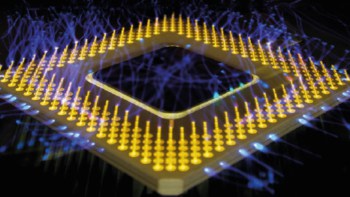
A new method of fabricating nanoscale optical crystals capable of converting infrared to visible light has been developed by researchers in Australia, China and Italy. The new technique allows the crystals to be placed onto glass and could lead to improvements in holographic imaging – and even the development of improved night-vision goggles.
Second-harmonic generation, or frequency doubling, is an optical process whereby two photons with the same frequency are combined within a nonlinear material to form a single photon with twice the frequency (and half the wavelength) of the original photons. The process is commonly used by the laser industry, in which green 532 nm laser light is produced from a 1064 nm infrared source. Recent developments in nanotechnology have opened up the potential for efficient frequency doubling using nanoscale crystals – potentially enabling a variety of novel applications.
Materials with second-order nonlinear susceptibilities – such as gallium arsenide (GaAs) and aluminium gallium arsenide (AlGaAs) – are of particular interest for these applications because their low-order nonlinearity makes them efficient at conversion.
Substrate mismatch
To be able to exploit second-harmonic generation in a practical device, these nanostructures must be fabricated on a substrate with a relatively low refractive index (such as glass), so that light may pass through the optical device. This is challenging, however, because the growth of GaAs-based crystals in a thin film – and type III-V semiconductors in general – requires a crystalline substrate.
“This is why growing a layer of AlGaAs on top of a low-refractive-index substrate, like glass, leads to unmatched lattice parameters, which causes crystalline defects,” explains Dragomir Neshev, a physicist at the Australian National University (ANU). These defects, he adds, result in unwanted changes in the electronic, mechanical, optical and thermal properties of the films.
The nanocrystals are so small they could be fitted as an ultrathin film to normal eye glasses to enable night vision
Dragomir Neshev, ANU
Previous attempts to overcome this issue have led to poor results. One approach, for example, relies on placing a buffer layer under the AlGaAs films, which is then oxidized. However, these buffer layers tend to have higher refractive indices than regular glass substrates. Alternatively, AlGaAs films can be transferred to a glass surface prior to the fabrication of the nanostructures. In this case the result is poor-quality nanocrystals.
Best of both
The new study was done by Neshev and colleagues at ANU, Nankai University and the University of Brescia, who combined the advantages of the two different approaches to develop a new fabrication method. First, high-quality disc-shaped nanocrystals about 500 nm in diameter are fabricated using electron-beam lithography on a GaAs wafer, with a layer of AlAs acting as a buffer between the two. The buffer is then dissolved, and the discs are coated in a transparent layer of benzocyclobutene. This can then be attached to the glass substrate, and the GaAs wafer peeled off with minimal damage to the nanostructures.
The development could have various applications. “The nanocrystals are so small they could be fitted as an ultrathin film to normal eye glasses to enable night vision,” says Neshev, explaining that, by combining frequency doubling with other nonlinear interactions, the film might be used to convert invisible, infrared light to the visible spectrum.
If they could be made, such modified glasses would be an improvement on conventional night-vision binoculars, which tend to be large and cumbersome. To this end, the team is working to scale up the size of the nanocrystal films to cover the area of typical spectacle lenses, and expects to have a prototype device completed within the next five years.
Security holograms
Alongside frequency doubling, the team was also able to tune the nanodiscs to control the direction and polarization of the emitted light, which makes the film more efficient. “Next, maybe we can even engineer the light and make complex shapes such as nonlinear holograms for security markers,” says Neshev, adding: “Engineering of the exact polarization of the emission is also important for other applications such as microscopy, which allows light to be focused to a smaller volume.”
“Vector beams with spatially arranged polarization distributions have attracted great interest for their applications in a variety of technical areas,” says Qiwen Zhan, an engineer at the University of Dayton in Ohio, who was not involved in this study. The novel fabrication technique, he adds, “opens a new avenue for generating vector fields at different frequencies through nonlinear optical processes”.
With their initial study complete, Neshev and colleagues are now looking to refine their nanoantennas, both to increase the efficiency of the wavelength conversion process but also to extend the effects to other nonlinear interactions such as down-conversion.
The research is described in the journal Nano Letters.


